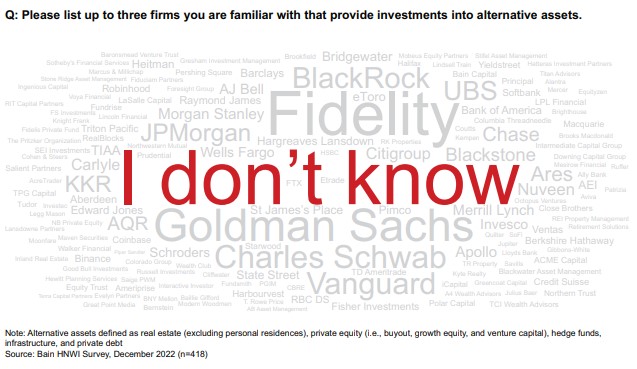
I Don't Know
I ask every guest on the podcast “What is your biggest investment pet peeve?”
Mine is investors who express absolutes in a world of probabilities. The late Peter Bernstein defined risk as “you don’t know what will happen,” adding “even when you think you do.” There’s a fine line that investors walk between conviction and humility, but those who believe they know the future without a shadow of a doubt fall a notch in my estimation.[1]
At the end of my last blog, Playing for Tomorrow, I shared a series of opportunities and risks that I believe have a greater than 50% chance of occurring. But the truth is I don’t know what the future holds. Of course I don’t; It sounds so obvious when I say it that way. Yet every day we see market participants behaving as if they do. It’s what forms bubbles in markets and what makes for great television on CNBC.
I thought about the important investment phrase – “I don’t know” – when reading a Bain & Company study on the private wealth market. Matt Brown from CAIS shared mind-blowing data about the tidal wave of capital coming to alternatives from the channel on the podcast last year. However, when Bain asked wealth managers for the names of firms that offer alternative investments, here is what they found:

I would have presumed that Blackstone, Ares, KKR, and other alternative asset market leaders were already well-known brands in the democratization of alternatives, but the playing field is either wide open or a firm called I Don’t Know Asset Management is secretly crushing it.
Turning to investing, here’s a set of questions I’ve been thinking about for which “I don’t know” is my best answer:
Are High Levels of Government Debt Sustainable? I don’t know. In their 2009 book This Time Is Different, Carmen Reinhardt and Ken Rogoff made the case that countries hit an economic slowdown and intractable debt spiral when their debt-to-GDP rises above 90%. Along these lines of thinking, Stanley Druckenmiller recently said, “The debt ceiling is like sitting on the Santa Monica pier and you see a thirty-foot wave and you’re worried about it. There’s a two-hundred-foot tsunami ten miles out, but all we talk about is the wave.”[2]The interest on the debt consuming the Federal budget down the road sounds like a big problem waiting to happen, but is it really as straightforward as Druckenmiller believes? Setting aside the fact that Reinhardt and Rogoff’s data set and analysis had errors, the debt in the U.S. and many other countries around the world has been well above those 90% levels for a long time.[3] Why hasn’t it come to roost yet when markets generally do such a good job at discounting the future?
Is Asset Allocation the Most Important Driver of Returns? I don’t know. Capital allocators anchor their portfolios on the belief that asset allocation is the most important driver of returns. The famous Brinson study from 1986 stating that asset allocation drives 90% of returns has been interpreted in ways the study never intended. The research used a backward-looking return stream to conduct performance attribution across investment policy, market timing, and security selection.[4] Nothing about the study indicated that asset allocation would determine future returns. In fact, the same proponents of asset allocation as a driver of returns often dismiss anyone’s ability to time markets. If you don’t know which asset class will outperform and can’t time markets, how can asset allocation be useful as the most important driver of future returns?
Some aspects of mean-variable optimization models make sense. For example, stocks need to earn a risk premium over bonds over a long period of time for capitalism to function. Then again, institutional policy portfolios with long-term horizons are regularly adjusted every year, hardly giving credence to the policy set last year as one for the long-term. Asset allocation is a wonderful communication tool and a useful way to describe returns in the rear-view mirror, but I don’t know if it makes sense to put that stake in the ground that asset allocation matters most for institutional portfolio outcomes.
What Happens Across the Food Chain of Capital in a Slowdown? I don’t know. Last year public markets sold off, particularly in the technology sector. Concurrently, the well ran dry for late-stage venture companies. The combination of the public market decline (denominator effect) and prior private market boom in 2021 (numerator effect) left the allocator community slowing the pace of their commitments to private equity and venture funds and reducing the size of the commitments they do make.
What happens when companies need more capital? Will the dry powder already in the hands of private market managers fill financing needs or will we see a wave of bankruptcies? If the latter, what effect will that have on other assets across the food chain of capital?
Where Will the Stock Market Go? I don’t know. Predicting if the stock market will go up or down in the near term, medium term, or even the next decade is a folly.
Here’s a fun story that brings that to light. When Warren Buffett and I made our ten-year charitable bet pitting hedge funds against the market starting in 2008, we split the future proceeds of the bet and bought a zero-coupon bond that would mature ten years later for $1 million to be awarded to the winner’s chosen charity. The bet became the headliner for longbets.org, a non-profit created to improve long-term thinking. Alongside our respective arguments, anyone could comment on the bet. The consensus from the public at the time was that we were both stupid for putting the proceeds of the bet in a Treasury bond. We were castigated for hurting the charities, who obviously would benefit by having the money in the stock market, Berkshire stock, hedge funds, or anything else that would compound capital over the decade by far more than the risk-free bond in a risk-seeking world.
That’s not how it played out. A year into the wager the financial crisis hit, rates dropped to zero, and the long-duration zero-coupon bond was one of the highest-performing investments available at the time. About halfway through the bet, we sold the bond for close to par and bought Berkshire Hathaway stock, coincidentally a few months before Warren bought back shares for the very first time. By the end of the decade, our intended $1 million had grown to north of $2 million, far surpassing either side of our carefully thought-out investment strategy in the bet. Everyone thought we were stupid, but they were wrong. I didn’t know where the market was heading then, and I don’t know now – up or down, by a little or a lot, with volatility or calm.
Is Private Credit an Opportunity or a Risk? I don’t know. Marc Lasry spoke on the podcast about an attractive opportunity to earn 12-14% making senior secured loans to mid-sized private companies because of a dearth of capital available from banks. That sounds like an amazing risk-reward, but it’s probably not sustainable. The economy can’t function with that cost of capital and would experience a wave of defaults. After taking into account the potential for losses from defaults, is private credit an opportunity or a risk?
Additionally, I don’t know if liquidity is an asset or a liability in private credit. Tony Yoseloff made a compelling case for the value of opportunistic credit in institutional portfolios based on its steady yield to assist with annual spending needs. On the other hand, when the Fed’s liquidity tap runs dry and capital stops flowing into private credit, I don’t know who holds the bag when companies, money managers, and institutional pools of capital need to get out.
When Does This Get Easier? I don’t know. I like to say, the hardest day to invest is always today and the May 2023 version of today is no different. If there’s one consensus from my conversations with practitioners, it’s that uncertainty is at an apex. It’s a good time to remember that “I don’t know” is a valuable response to almost any investment question.
Before closing this out, I’d like to turn to a personal uncertainty that, at age 52, has been on my mind as of late. In the past year, we lost great investors David Swensen, Danny Offit, Randy Kim, Sam Zell, and many others. These four men were my most cherished mentor, two valued peers and friends, and the most popular guest on the podcast, respectively. It has me thinking about the most existential question of them all.
What Happens to Us When We Die? I used to be afraid of death. While out in the mountains with Michael Mervosh and the Hero’s Journey Foundation several years ago, I looked around and saw that everything in nature regenerates itself when it dies. I asked myself “Why won’t we?”
I realized my fears of death were based on a belief I held, with certainty, that when we die, we are alone in eternal nothingness. No wonder I was so afraid of death. In that moment in the woods, I realized the flaw in my foolish certainty and replaced the belief with a range of uncertain possibilities, including the polar opposite of my prior belief that we will regenerate in many future lives for eternity. The alternate nodes on the probability tree of life lifted my spirits with optimism and has reduced my fears ever since.
I don’t know where David, Danny, Randy, and Sam are now. I want to believe they are living their best lives with a newfound level of consciousness and wisdom unattainable on Earth. If that is the case, I’d bet Warren again that they’re laughing at how much we think we know.
[1] It’s not just in investing where my pet peeve runs amok. My wife would happily share her frequent frustration from my oft-repeated response “Maybe” to anything she expresses with certainty.
[2] https://uscmarshallweb.s3-us-west-2.amazonaws.com/assets/uploads/s1/files/keynote_speech_of_stan_druckenmiller_at_the_37th_usc_marshall_center_for_investment_studies_annual_meeting_may_1_2023_hdmqn6eb4m.pdf
[3] https://theconversation.com/the-reinhart-rogoff-error-or-how-not-to-excel-at-economics-13646
[4] Determinants of Portfolio Performance, Gary Brinson, Randolph Hood, and Gilbert Beebower, Financial Analysts Journal, July-August 1986.
